Corporation Law Assignment Sample PDF
VerifiedAdded on 2021/01/03
|11
|2669
|29
AI Summary
Contribute Materials
Your contribution can guide someone’s learning journey. Share your
documents today.
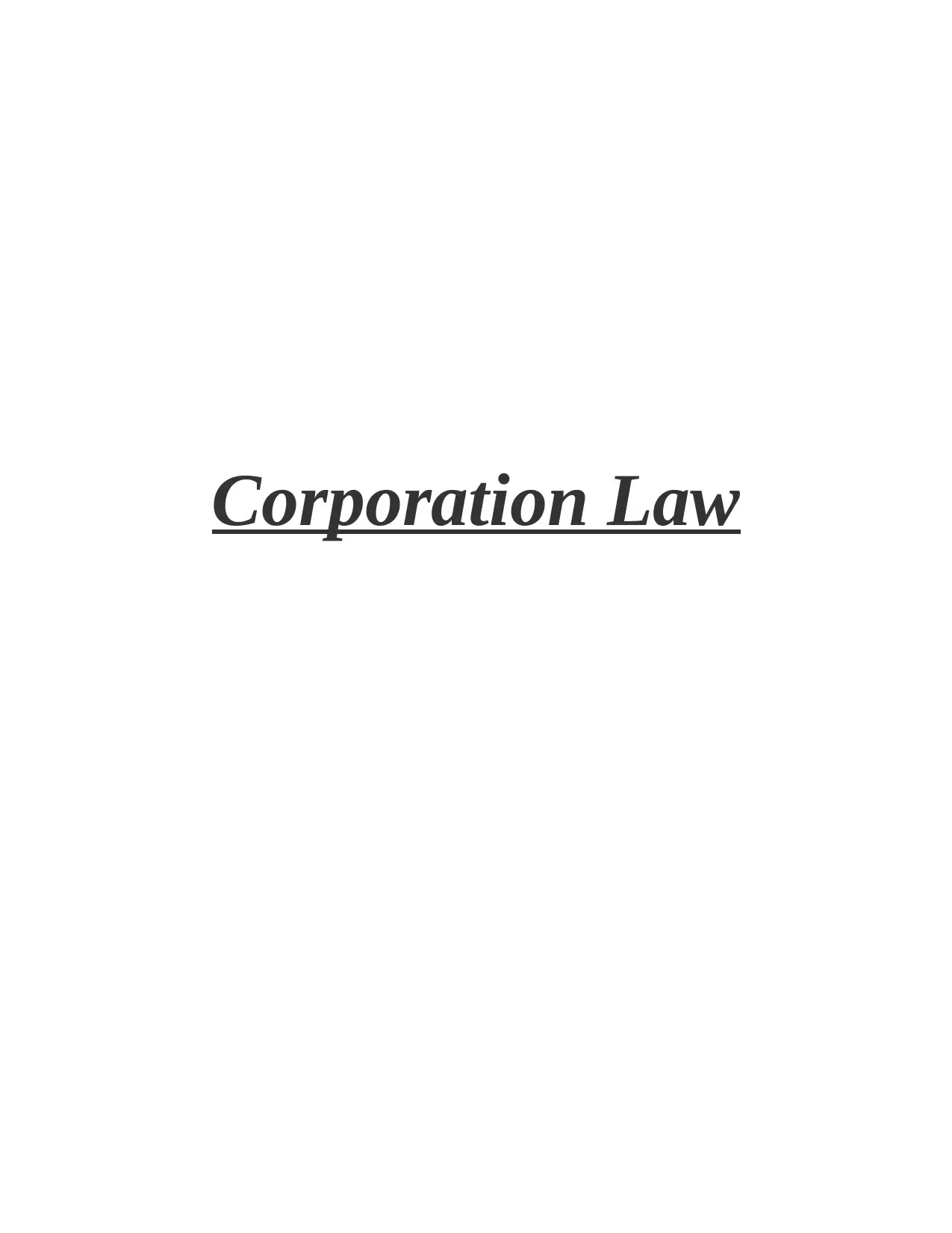
Corporation Law
Secure Best Marks with AI Grader
Need help grading? Try our AI Grader for instant feedback on your assignments.
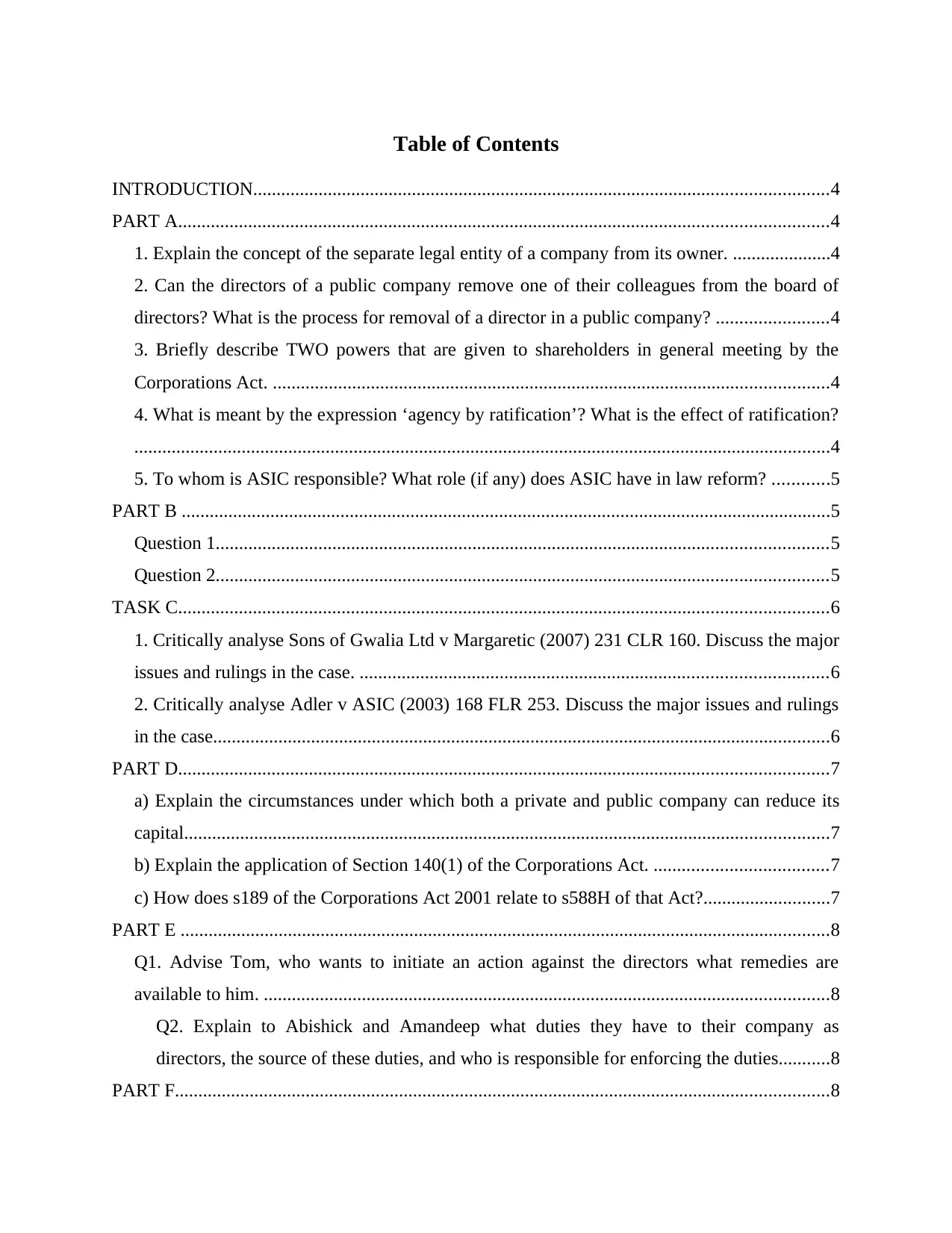
Table of Contents
INTRODUCTION...........................................................................................................................4
PART A...........................................................................................................................................4
1. Explain the concept of the separate legal entity of a company from its owner. .....................4
2. Can the directors of a public company remove one of their colleagues from the board of
directors? What is the process for removal of a director in a public company? ........................4
3. Briefly describe TWO powers that are given to shareholders in general meeting by the
Corporations Act. .......................................................................................................................4
4. What is meant by the expression ‘agency by ratification’? What is the effect of ratification?
.....................................................................................................................................................4
5. To whom is ASIC responsible? What role (if any) does ASIC have in law reform? ............5
PART B ...........................................................................................................................................5
Question 1...................................................................................................................................5
Question 2...................................................................................................................................5
TASK C...........................................................................................................................................6
1. Critically analyse Sons of Gwalia Ltd v Margaretic (2007) 231 CLR 160. Discuss the major
issues and rulings in the case. ....................................................................................................6
2. Critically analyse Adler v ASIC (2003) 168 FLR 253. Discuss the major issues and rulings
in the case....................................................................................................................................6
PART D...........................................................................................................................................7
a) Explain the circumstances under which both a private and public company can reduce its
capital..........................................................................................................................................7
b) Explain the application of Section 140(1) of the Corporations Act. .....................................7
c) How does s189 of the Corporations Act 2001 relate to s588H of that Act?...........................7
PART E ...........................................................................................................................................8
Q1. Advise Tom, who wants to initiate an action against the directors what remedies are
available to him. .........................................................................................................................8
Q2. Explain to Abishick and Amandeep what duties they have to their company as
directors, the source of these duties, and who is responsible for enforcing the duties...........8
PART F............................................................................................................................................8
INTRODUCTION...........................................................................................................................4
PART A...........................................................................................................................................4
1. Explain the concept of the separate legal entity of a company from its owner. .....................4
2. Can the directors of a public company remove one of their colleagues from the board of
directors? What is the process for removal of a director in a public company? ........................4
3. Briefly describe TWO powers that are given to shareholders in general meeting by the
Corporations Act. .......................................................................................................................4
4. What is meant by the expression ‘agency by ratification’? What is the effect of ratification?
.....................................................................................................................................................4
5. To whom is ASIC responsible? What role (if any) does ASIC have in law reform? ............5
PART B ...........................................................................................................................................5
Question 1...................................................................................................................................5
Question 2...................................................................................................................................5
TASK C...........................................................................................................................................6
1. Critically analyse Sons of Gwalia Ltd v Margaretic (2007) 231 CLR 160. Discuss the major
issues and rulings in the case. ....................................................................................................6
2. Critically analyse Adler v ASIC (2003) 168 FLR 253. Discuss the major issues and rulings
in the case....................................................................................................................................6
PART D...........................................................................................................................................7
a) Explain the circumstances under which both a private and public company can reduce its
capital..........................................................................................................................................7
b) Explain the application of Section 140(1) of the Corporations Act. .....................................7
c) How does s189 of the Corporations Act 2001 relate to s588H of that Act?...........................7
PART E ...........................................................................................................................................8
Q1. Advise Tom, who wants to initiate an action against the directors what remedies are
available to him. .........................................................................................................................8
Q2. Explain to Abishick and Amandeep what duties they have to their company as
directors, the source of these duties, and who is responsible for enforcing the duties...........8
PART F............................................................................................................................................8
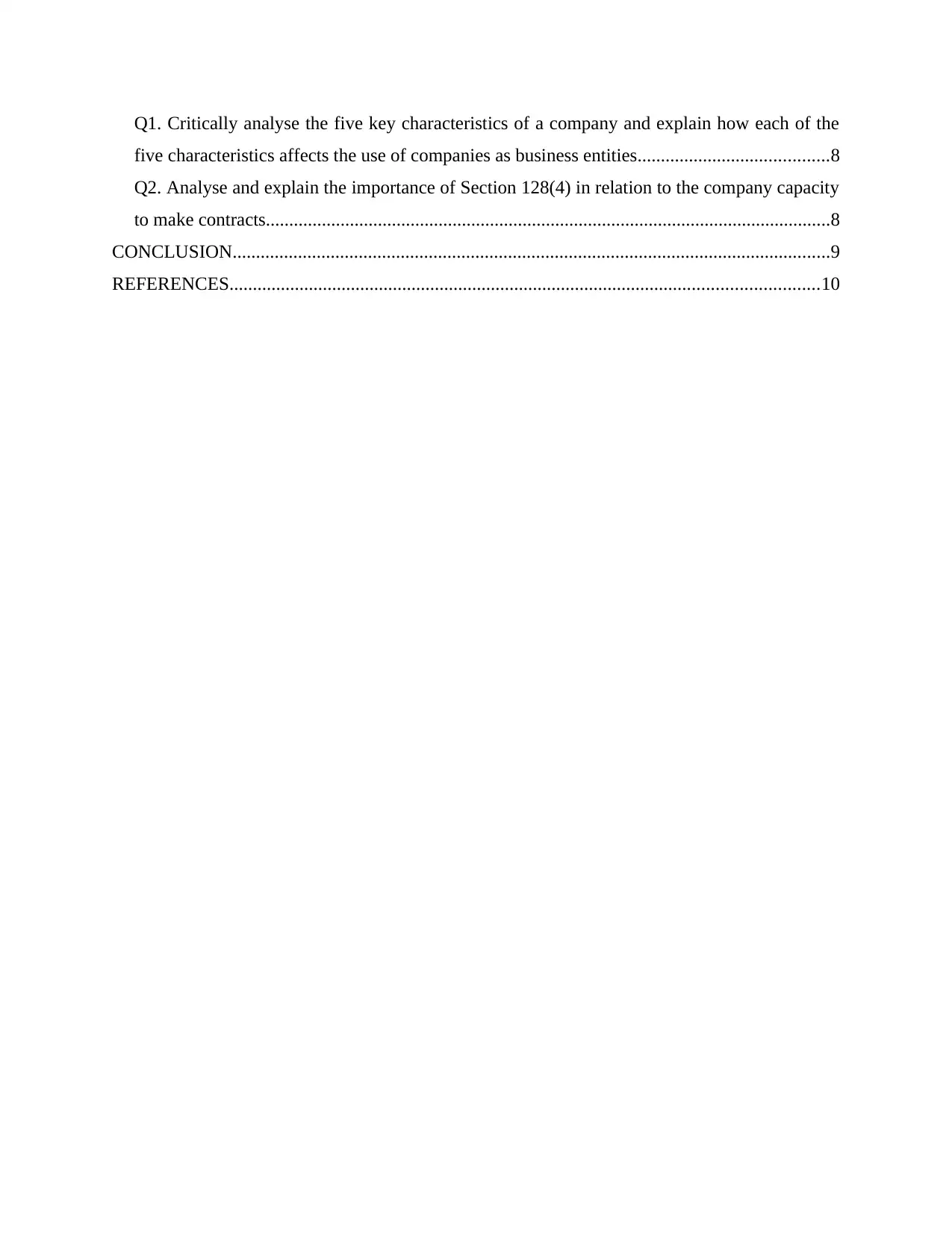
Q1. Critically analyse the five key characteristics of a company and explain how each of the
five characteristics affects the use of companies as business entities.........................................8
Q2. Analyse and explain the importance of Section 128(4) in relation to the company capacity
to make contracts.........................................................................................................................8
CONCLUSION................................................................................................................................9
REFERENCES..............................................................................................................................10
five characteristics affects the use of companies as business entities.........................................8
Q2. Analyse and explain the importance of Section 128(4) in relation to the company capacity
to make contracts.........................................................................................................................8
CONCLUSION................................................................................................................................9
REFERENCES..............................................................................................................................10
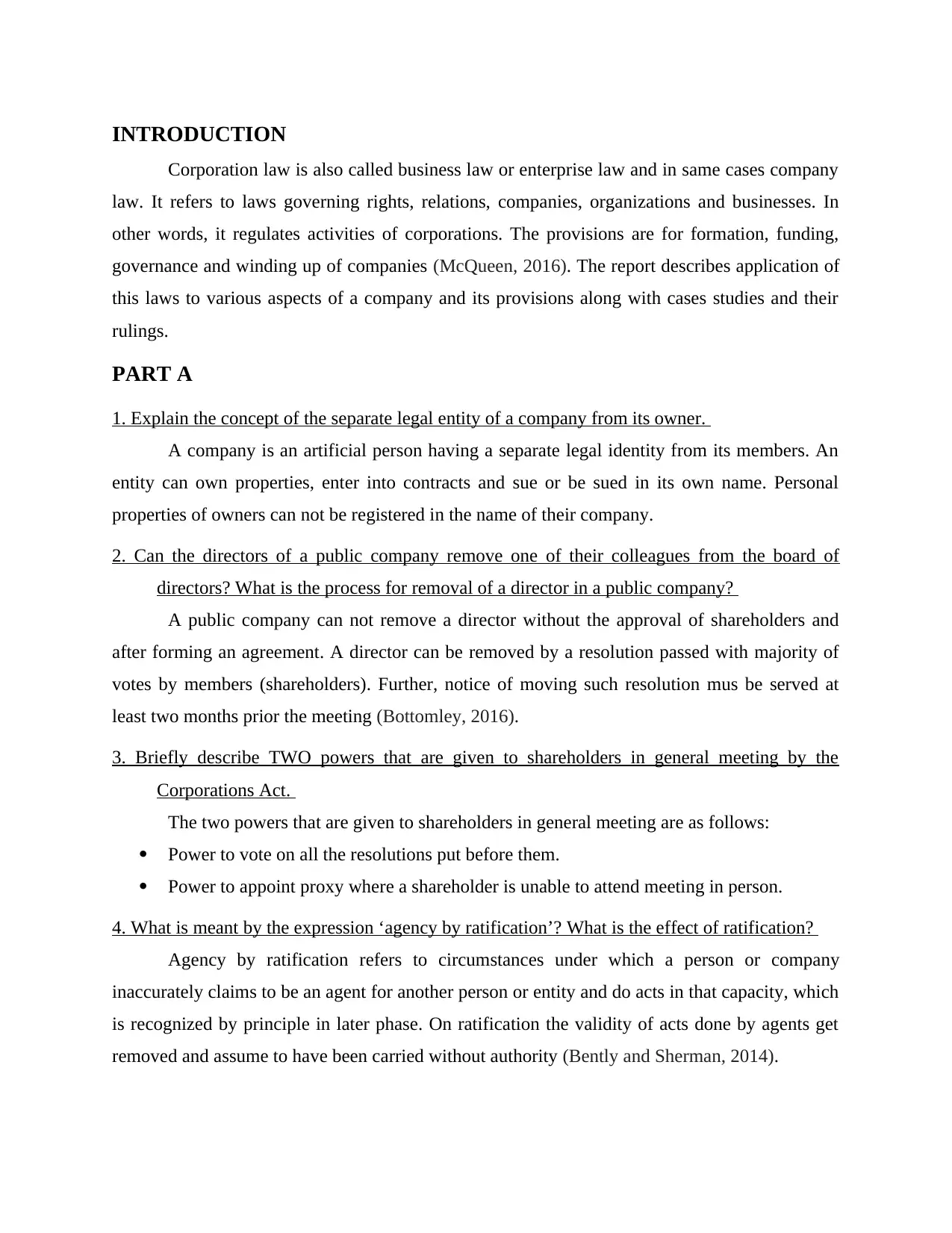
INTRODUCTION
Corporation law is also called business law or enterprise law and in same cases company
law. It refers to laws governing rights, relations, companies, organizations and businesses. In
other words, it regulates activities of corporations. The provisions are for formation, funding,
governance and winding up of companies (McQueen, 2016). The report describes application of
this laws to various aspects of a company and its provisions along with cases studies and their
rulings.
PART A
1. Explain the concept of the separate legal entity of a company from its owner.
A company is an artificial person having a separate legal identity from its members. An
entity can own properties, enter into contracts and sue or be sued in its own name. Personal
properties of owners can not be registered in the name of their company.
2. Can the directors of a public company remove one of their colleagues from the board of
directors? What is the process for removal of a director in a public company?
A public company can not remove a director without the approval of shareholders and
after forming an agreement. A director can be removed by a resolution passed with majority of
votes by members (shareholders). Further, notice of moving such resolution mus be served at
least two months prior the meeting (Bottomley, 2016).
3. Briefly describe TWO powers that are given to shareholders in general meeting by the
Corporations Act.
The two powers that are given to shareholders in general meeting are as follows:
Power to vote on all the resolutions put before them.
Power to appoint proxy where a shareholder is unable to attend meeting in person.
4. What is meant by the expression ‘agency by ratification’? What is the effect of ratification?
Agency by ratification refers to circumstances under which a person or company
inaccurately claims to be an agent for another person or entity and do acts in that capacity, which
is recognized by principle in later phase. On ratification the validity of acts done by agents get
removed and assume to have been carried without authority (Bently and Sherman, 2014).
Corporation law is also called business law or enterprise law and in same cases company
law. It refers to laws governing rights, relations, companies, organizations and businesses. In
other words, it regulates activities of corporations. The provisions are for formation, funding,
governance and winding up of companies (McQueen, 2016). The report describes application of
this laws to various aspects of a company and its provisions along with cases studies and their
rulings.
PART A
1. Explain the concept of the separate legal entity of a company from its owner.
A company is an artificial person having a separate legal identity from its members. An
entity can own properties, enter into contracts and sue or be sued in its own name. Personal
properties of owners can not be registered in the name of their company.
2. Can the directors of a public company remove one of their colleagues from the board of
directors? What is the process for removal of a director in a public company?
A public company can not remove a director without the approval of shareholders and
after forming an agreement. A director can be removed by a resolution passed with majority of
votes by members (shareholders). Further, notice of moving such resolution mus be served at
least two months prior the meeting (Bottomley, 2016).
3. Briefly describe TWO powers that are given to shareholders in general meeting by the
Corporations Act.
The two powers that are given to shareholders in general meeting are as follows:
Power to vote on all the resolutions put before them.
Power to appoint proxy where a shareholder is unable to attend meeting in person.
4. What is meant by the expression ‘agency by ratification’? What is the effect of ratification?
Agency by ratification refers to circumstances under which a person or company
inaccurately claims to be an agent for another person or entity and do acts in that capacity, which
is recognized by principle in later phase. On ratification the validity of acts done by agents get
removed and assume to have been carried without authority (Bently and Sherman, 2014).
Paraphrase This Document
Need a fresh take? Get an instant paraphrase of this document with our AI Paraphraser
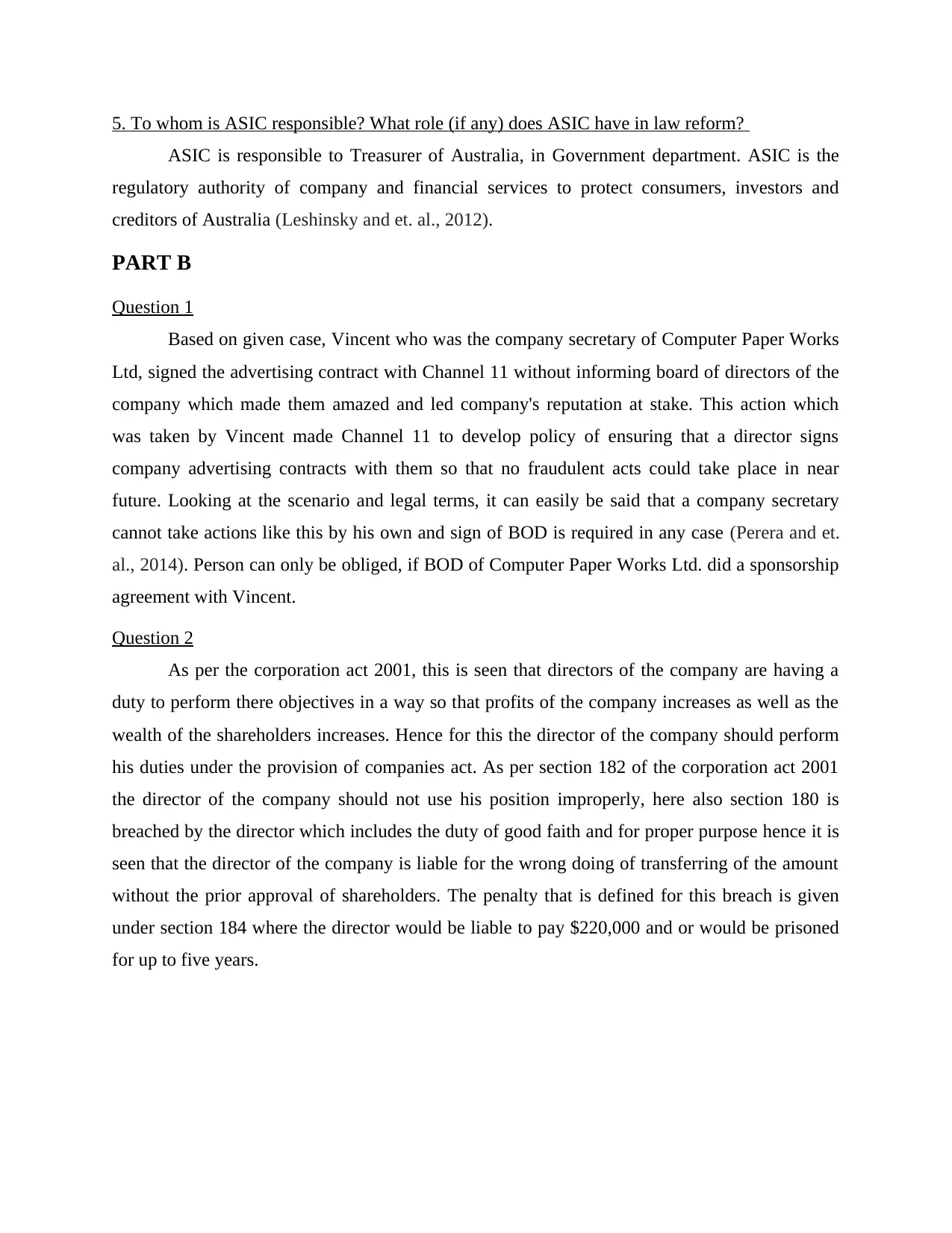
5. To whom is ASIC responsible? What role (if any) does ASIC have in law reform?
ASIC is responsible to Treasurer of Australia, in Government department. ASIC is the
regulatory authority of company and financial services to protect consumers, investors and
creditors of Australia (Leshinsky and et. al., 2012).
PART B
Question 1
Based on given case, Vincent who was the company secretary of Computer Paper Works
Ltd, signed the advertising contract with Channel 11 without informing board of directors of the
company which made them amazed and led company's reputation at stake. This action which
was taken by Vincent made Channel 11 to develop policy of ensuring that a director signs
company advertising contracts with them so that no fraudulent acts could take place in near
future. Looking at the scenario and legal terms, it can easily be said that a company secretary
cannot take actions like this by his own and sign of BOD is required in any case (Perera and et.
al., 2014). Person can only be obliged, if BOD of Computer Paper Works Ltd. did a sponsorship
agreement with Vincent.
Question 2
As per the corporation act 2001, this is seen that directors of the company are having a
duty to perform there objectives in a way so that profits of the company increases as well as the
wealth of the shareholders increases. Hence for this the director of the company should perform
his duties under the provision of companies act. As per section 182 of the corporation act 2001
the director of the company should not use his position improperly, here also section 180 is
breached by the director which includes the duty of good faith and for proper purpose hence it is
seen that the director of the company is liable for the wrong doing of transferring of the amount
without the prior approval of shareholders. The penalty that is defined for this breach is given
under section 184 where the director would be liable to pay $220,000 and or would be prisoned
for up to five years.
ASIC is responsible to Treasurer of Australia, in Government department. ASIC is the
regulatory authority of company and financial services to protect consumers, investors and
creditors of Australia (Leshinsky and et. al., 2012).
PART B
Question 1
Based on given case, Vincent who was the company secretary of Computer Paper Works
Ltd, signed the advertising contract with Channel 11 without informing board of directors of the
company which made them amazed and led company's reputation at stake. This action which
was taken by Vincent made Channel 11 to develop policy of ensuring that a director signs
company advertising contracts with them so that no fraudulent acts could take place in near
future. Looking at the scenario and legal terms, it can easily be said that a company secretary
cannot take actions like this by his own and sign of BOD is required in any case (Perera and et.
al., 2014). Person can only be obliged, if BOD of Computer Paper Works Ltd. did a sponsorship
agreement with Vincent.
Question 2
As per the corporation act 2001, this is seen that directors of the company are having a
duty to perform there objectives in a way so that profits of the company increases as well as the
wealth of the shareholders increases. Hence for this the director of the company should perform
his duties under the provision of companies act. As per section 182 of the corporation act 2001
the director of the company should not use his position improperly, here also section 180 is
breached by the director which includes the duty of good faith and for proper purpose hence it is
seen that the director of the company is liable for the wrong doing of transferring of the amount
without the prior approval of shareholders. The penalty that is defined for this breach is given
under section 184 where the director would be liable to pay $220,000 and or would be prisoned
for up to five years.
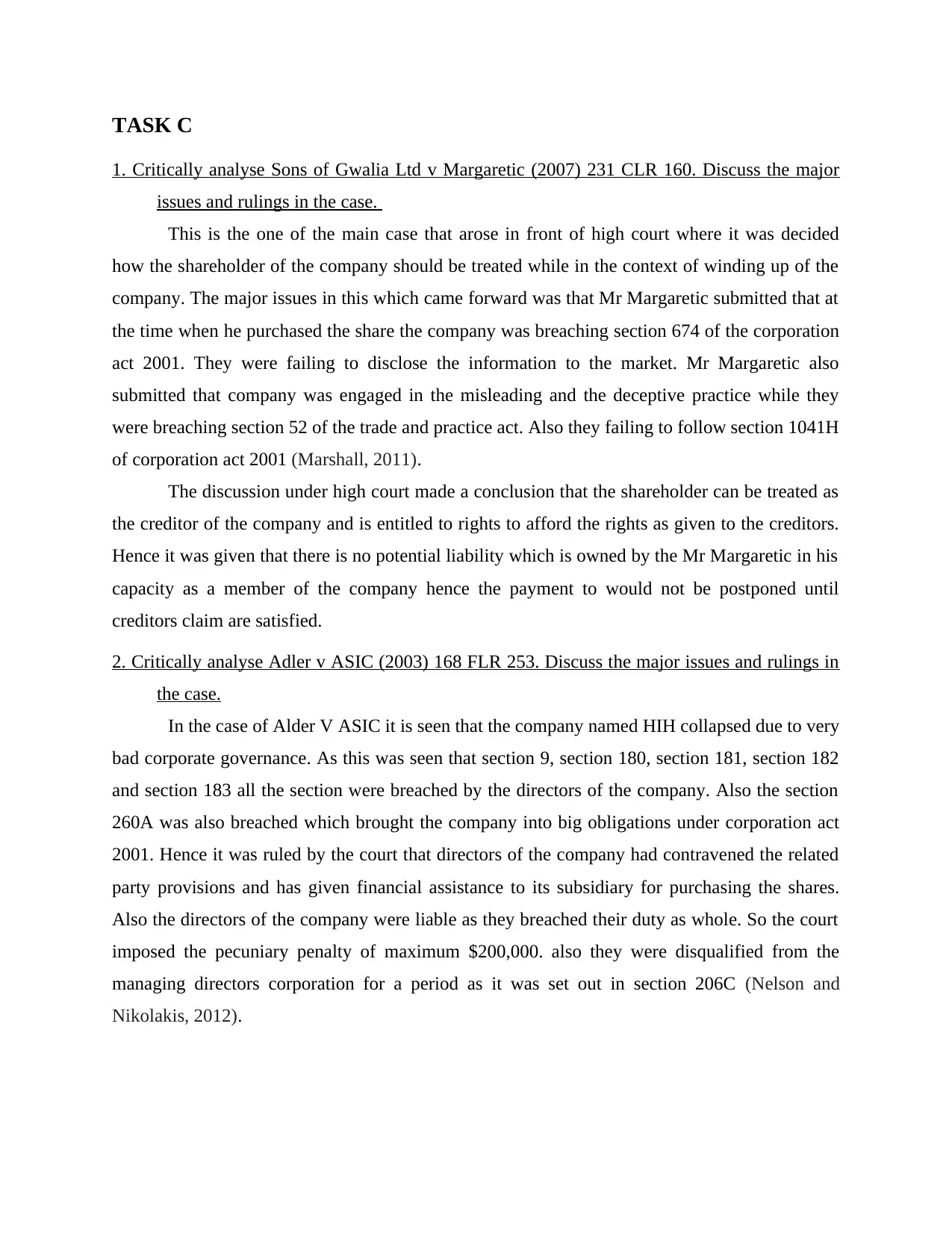
TASK C
1. Critically analyse Sons of Gwalia Ltd v Margaretic (2007) 231 CLR 160. Discuss the major
issues and rulings in the case.
This is the one of the main case that arose in front of high court where it was decided
how the shareholder of the company should be treated while in the context of winding up of the
company. The major issues in this which came forward was that Mr Margaretic submitted that at
the time when he purchased the share the company was breaching section 674 of the corporation
act 2001. They were failing to disclose the information to the market. Mr Margaretic also
submitted that company was engaged in the misleading and the deceptive practice while they
were breaching section 52 of the trade and practice act. Also they failing to follow section 1041H
of corporation act 2001 (Marshall, 2011).
The discussion under high court made a conclusion that the shareholder can be treated as
the creditor of the company and is entitled to rights to afford the rights as given to the creditors.
Hence it was given that there is no potential liability which is owned by the Mr Margaretic in his
capacity as a member of the company hence the payment to would not be postponed until
creditors claim are satisfied.
2. Critically analyse Adler v ASIC (2003) 168 FLR 253. Discuss the major issues and rulings in
the case.
In the case of Alder V ASIC it is seen that the company named HIH collapsed due to very
bad corporate governance. As this was seen that section 9, section 180, section 181, section 182
and section 183 all the section were breached by the directors of the company. Also the section
260A was also breached which brought the company into big obligations under corporation act
2001. Hence it was ruled by the court that directors of the company had contravened the related
party provisions and has given financial assistance to its subsidiary for purchasing the shares.
Also the directors of the company were liable as they breached their duty as whole. So the court
imposed the pecuniary penalty of maximum $200,000. also they were disqualified from the
managing directors corporation for a period as it was set out in section 206C (Nelson and
Nikolakis, 2012).
1. Critically analyse Sons of Gwalia Ltd v Margaretic (2007) 231 CLR 160. Discuss the major
issues and rulings in the case.
This is the one of the main case that arose in front of high court where it was decided
how the shareholder of the company should be treated while in the context of winding up of the
company. The major issues in this which came forward was that Mr Margaretic submitted that at
the time when he purchased the share the company was breaching section 674 of the corporation
act 2001. They were failing to disclose the information to the market. Mr Margaretic also
submitted that company was engaged in the misleading and the deceptive practice while they
were breaching section 52 of the trade and practice act. Also they failing to follow section 1041H
of corporation act 2001 (Marshall, 2011).
The discussion under high court made a conclusion that the shareholder can be treated as
the creditor of the company and is entitled to rights to afford the rights as given to the creditors.
Hence it was given that there is no potential liability which is owned by the Mr Margaretic in his
capacity as a member of the company hence the payment to would not be postponed until
creditors claim are satisfied.
2. Critically analyse Adler v ASIC (2003) 168 FLR 253. Discuss the major issues and rulings in
the case.
In the case of Alder V ASIC it is seen that the company named HIH collapsed due to very
bad corporate governance. As this was seen that section 9, section 180, section 181, section 182
and section 183 all the section were breached by the directors of the company. Also the section
260A was also breached which brought the company into big obligations under corporation act
2001. Hence it was ruled by the court that directors of the company had contravened the related
party provisions and has given financial assistance to its subsidiary for purchasing the shares.
Also the directors of the company were liable as they breached their duty as whole. So the court
imposed the pecuniary penalty of maximum $200,000. also they were disqualified from the
managing directors corporation for a period as it was set out in section 206C (Nelson and
Nikolakis, 2012).
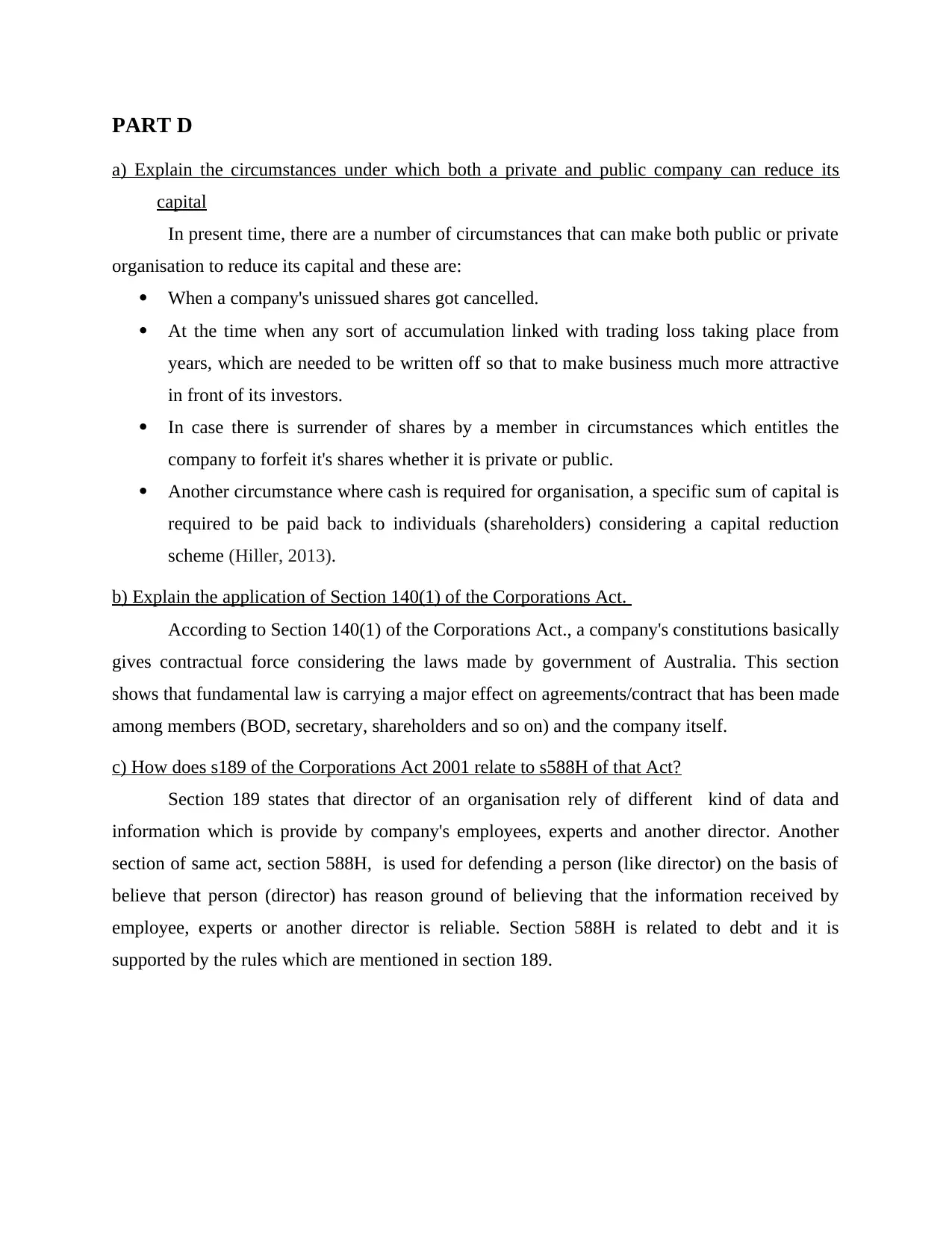
PART D
a) Explain the circumstances under which both a private and public company can reduce its
capital
In present time, there are a number of circumstances that can make both public or private
organisation to reduce its capital and these are:
When a company's unissued shares got cancelled.
At the time when any sort of accumulation linked with trading loss taking place from
years, which are needed to be written off so that to make business much more attractive
in front of its investors.
In case there is surrender of shares by a member in circumstances which entitles the
company to forfeit it's shares whether it is private or public.
Another circumstance where cash is required for organisation, a specific sum of capital is
required to be paid back to individuals (shareholders) considering a capital reduction
scheme (Hiller, 2013).
b) Explain the application of Section 140(1) of the Corporations Act.
According to Section 140(1) of the Corporations Act., a company's constitutions basically
gives contractual force considering the laws made by government of Australia. This section
shows that fundamental law is carrying a major effect on agreements/contract that has been made
among members (BOD, secretary, shareholders and so on) and the company itself.
c) How does s189 of the Corporations Act 2001 relate to s588H of that Act?
Section 189 states that director of an organisation rely of different kind of data and
information which is provide by company's employees, experts and another director. Another
section of same act, section 588H, is used for defending a person (like director) on the basis of
believe that person (director) has reason ground of believing that the information received by
employee, experts or another director is reliable. Section 588H is related to debt and it is
supported by the rules which are mentioned in section 189.
a) Explain the circumstances under which both a private and public company can reduce its
capital
In present time, there are a number of circumstances that can make both public or private
organisation to reduce its capital and these are:
When a company's unissued shares got cancelled.
At the time when any sort of accumulation linked with trading loss taking place from
years, which are needed to be written off so that to make business much more attractive
in front of its investors.
In case there is surrender of shares by a member in circumstances which entitles the
company to forfeit it's shares whether it is private or public.
Another circumstance where cash is required for organisation, a specific sum of capital is
required to be paid back to individuals (shareholders) considering a capital reduction
scheme (Hiller, 2013).
b) Explain the application of Section 140(1) of the Corporations Act.
According to Section 140(1) of the Corporations Act., a company's constitutions basically
gives contractual force considering the laws made by government of Australia. This section
shows that fundamental law is carrying a major effect on agreements/contract that has been made
among members (BOD, secretary, shareholders and so on) and the company itself.
c) How does s189 of the Corporations Act 2001 relate to s588H of that Act?
Section 189 states that director of an organisation rely of different kind of data and
information which is provide by company's employees, experts and another director. Another
section of same act, section 588H, is used for defending a person (like director) on the basis of
believe that person (director) has reason ground of believing that the information received by
employee, experts or another director is reliable. Section 588H is related to debt and it is
supported by the rules which are mentioned in section 189.
Secure Best Marks with AI Grader
Need help grading? Try our AI Grader for instant feedback on your assignments.
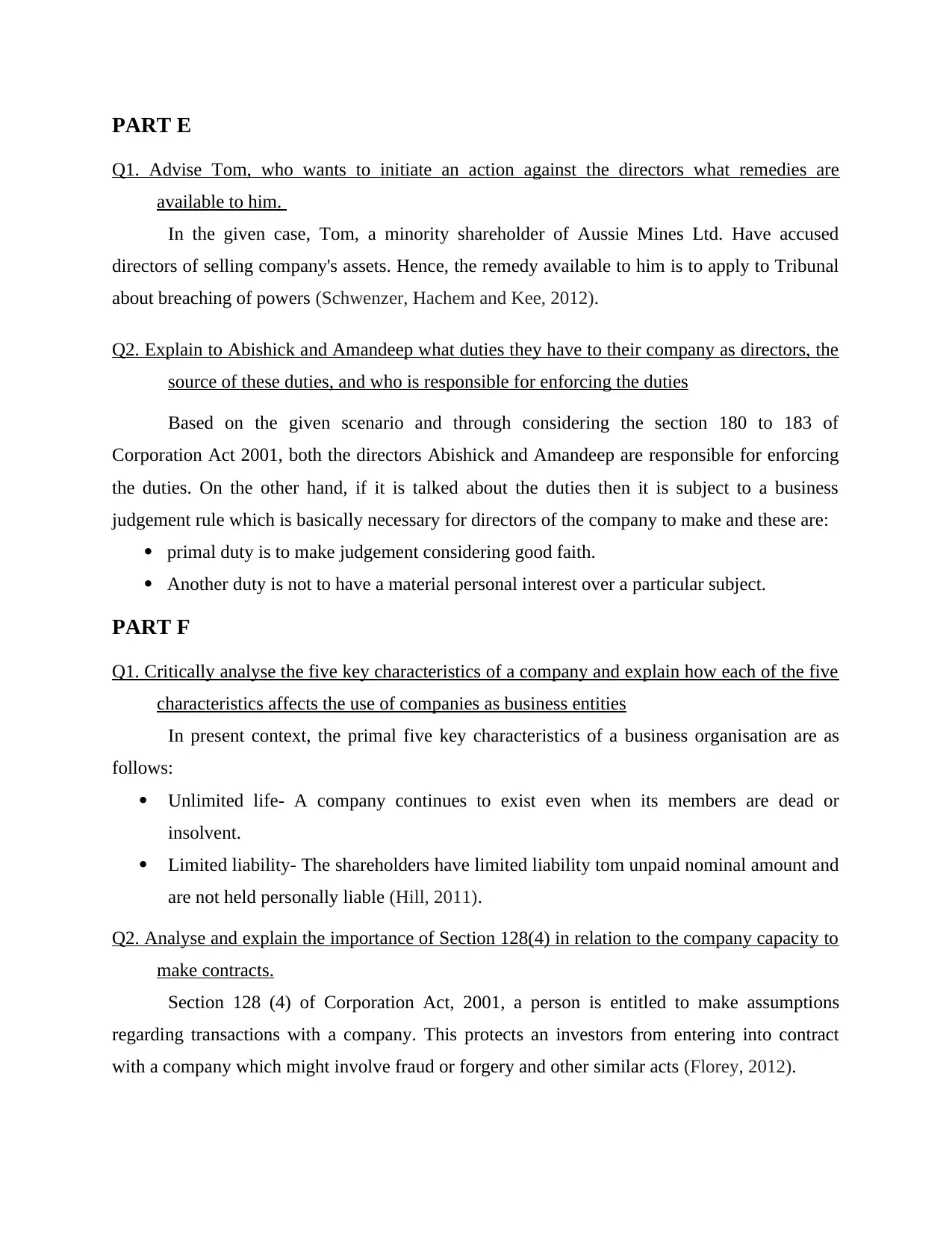
PART E
Q1. Advise Tom, who wants to initiate an action against the directors what remedies are
available to him.
In the given case, Tom, a minority shareholder of Aussie Mines Ltd. Have accused
directors of selling company's assets. Hence, the remedy available to him is to apply to Tribunal
about breaching of powers (Schwenzer, Hachem and Kee, 2012).
Q2. Explain to Abishick and Amandeep what duties they have to their company as directors, the
source of these duties, and who is responsible for enforcing the duties
Based on the given scenario and through considering the section 180 to 183 of
Corporation Act 2001, both the directors Abishick and Amandeep are responsible for enforcing
the duties. On the other hand, if it is talked about the duties then it is subject to a business
judgement rule which is basically necessary for directors of the company to make and these are:
primal duty is to make judgement considering good faith.
Another duty is not to have a material personal interest over a particular subject.
PART F
Q1. Critically analyse the five key characteristics of a company and explain how each of the five
characteristics affects the use of companies as business entities
In present context, the primal five key characteristics of a business organisation are as
follows:
Unlimited life- A company continues to exist even when its members are dead or
insolvent.
Limited liability- The shareholders have limited liability tom unpaid nominal amount and
are not held personally liable (Hill, 2011).
Q2. Analyse and explain the importance of Section 128(4) in relation to the company capacity to
make contracts.
Section 128 (4) of Corporation Act, 2001, a person is entitled to make assumptions
regarding transactions with a company. This protects an investors from entering into contract
with a company which might involve fraud or forgery and other similar acts (Florey, 2012).
Q1. Advise Tom, who wants to initiate an action against the directors what remedies are
available to him.
In the given case, Tom, a minority shareholder of Aussie Mines Ltd. Have accused
directors of selling company's assets. Hence, the remedy available to him is to apply to Tribunal
about breaching of powers (Schwenzer, Hachem and Kee, 2012).
Q2. Explain to Abishick and Amandeep what duties they have to their company as directors, the
source of these duties, and who is responsible for enforcing the duties
Based on the given scenario and through considering the section 180 to 183 of
Corporation Act 2001, both the directors Abishick and Amandeep are responsible for enforcing
the duties. On the other hand, if it is talked about the duties then it is subject to a business
judgement rule which is basically necessary for directors of the company to make and these are:
primal duty is to make judgement considering good faith.
Another duty is not to have a material personal interest over a particular subject.
PART F
Q1. Critically analyse the five key characteristics of a company and explain how each of the five
characteristics affects the use of companies as business entities
In present context, the primal five key characteristics of a business organisation are as
follows:
Unlimited life- A company continues to exist even when its members are dead or
insolvent.
Limited liability- The shareholders have limited liability tom unpaid nominal amount and
are not held personally liable (Hill, 2011).
Q2. Analyse and explain the importance of Section 128(4) in relation to the company capacity to
make contracts.
Section 128 (4) of Corporation Act, 2001, a person is entitled to make assumptions
regarding transactions with a company. This protects an investors from entering into contract
with a company which might involve fraud or forgery and other similar acts (Florey, 2012).

CONCLUSION
From the above, it has been concluded that corporation law is important to carry business
activities in a proper manner. This provides duties and responsibilities of directors and rights of
shareholders along with other provisions in order to protect any fraud or mismanagement.
From the above, it has been concluded that corporation law is important to carry business
activities in a proper manner. This provides duties and responsibilities of directors and rights of
shareholders along with other provisions in order to protect any fraud or mismanagement.
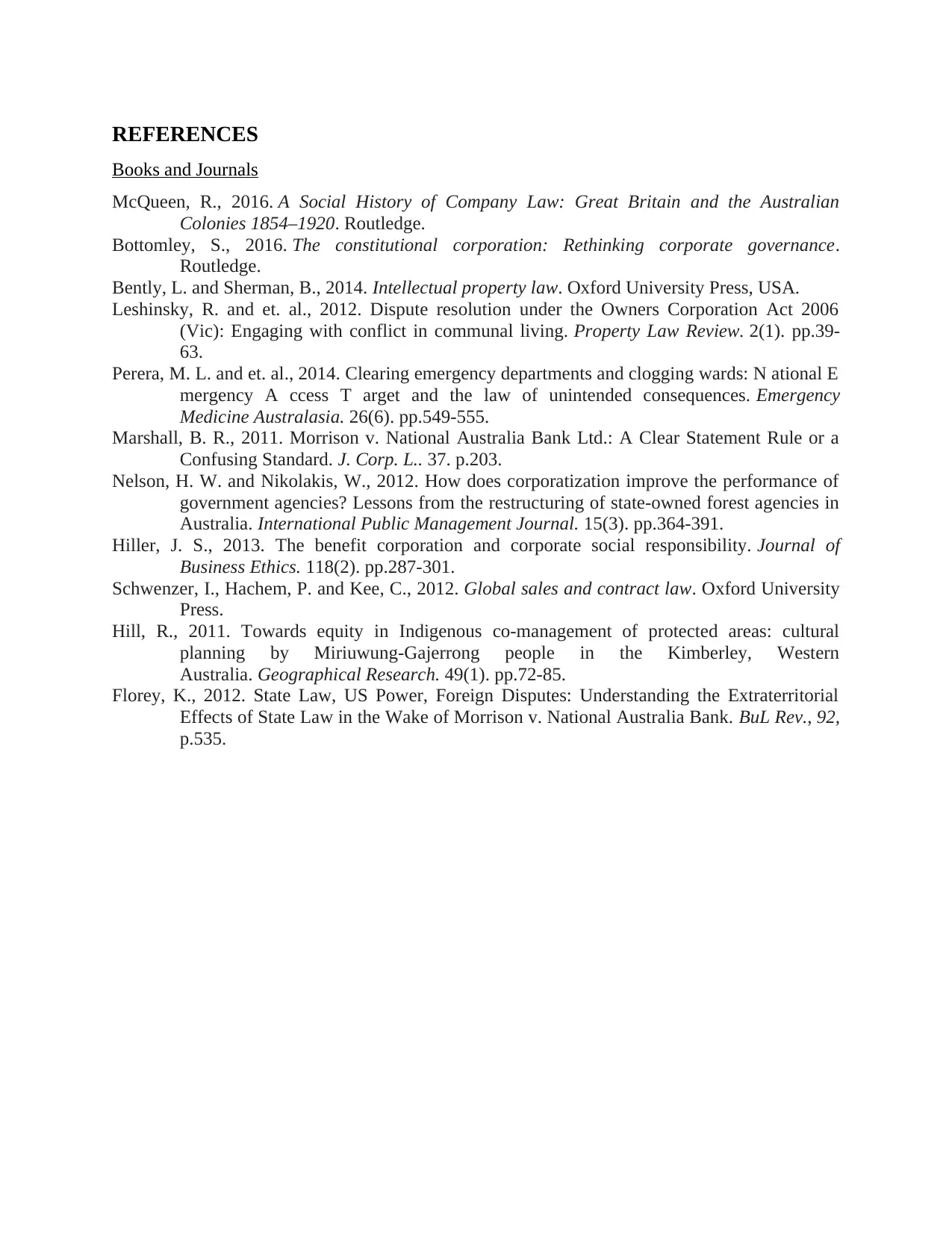
REFERENCES
Books and Journals
McQueen, R., 2016. A Social History of Company Law: Great Britain and the Australian
Colonies 1854–1920. Routledge.
Bottomley, S., 2016. The constitutional corporation: Rethinking corporate governance.
Routledge.
Bently, L. and Sherman, B., 2014. Intellectual property law. Oxford University Press, USA.
Leshinsky, R. and et. al., 2012. Dispute resolution under the Owners Corporation Act 2006
(Vic): Engaging with conflict in communal living. Property Law Review. 2(1). pp.39-
63.
Perera, M. L. and et. al., 2014. Clearing emergency departments and clogging wards: N ational E
mergency A ccess T arget and the law of unintended consequences. Emergency
Medicine Australasia. 26(6). pp.549-555.
Marshall, B. R., 2011. Morrison v. National Australia Bank Ltd.: A Clear Statement Rule or a
Confusing Standard. J. Corp. L.. 37. p.203.
Nelson, H. W. and Nikolakis, W., 2012. How does corporatization improve the performance of
government agencies? Lessons from the restructuring of state-owned forest agencies in
Australia. International Public Management Journal. 15(3). pp.364-391.
Hiller, J. S., 2013. The benefit corporation and corporate social responsibility. Journal of
Business Ethics. 118(2). pp.287-301.
Schwenzer, I., Hachem, P. and Kee, C., 2012. Global sales and contract law. Oxford University
Press.
Hill, R., 2011. Towards equity in Indigenous co‐management of protected areas: cultural
planning by Miriuwung‐Gajerrong people in the Kimberley, Western
Australia. Geographical Research. 49(1). pp.72-85.
Florey, K., 2012. State Law, US Power, Foreign Disputes: Understanding the Extraterritorial
Effects of State Law in the Wake of Morrison v. National Australia Bank. BuL Rev., 92,
p.535.
Books and Journals
McQueen, R., 2016. A Social History of Company Law: Great Britain and the Australian
Colonies 1854–1920. Routledge.
Bottomley, S., 2016. The constitutional corporation: Rethinking corporate governance.
Routledge.
Bently, L. and Sherman, B., 2014. Intellectual property law. Oxford University Press, USA.
Leshinsky, R. and et. al., 2012. Dispute resolution under the Owners Corporation Act 2006
(Vic): Engaging with conflict in communal living. Property Law Review. 2(1). pp.39-
63.
Perera, M. L. and et. al., 2014. Clearing emergency departments and clogging wards: N ational E
mergency A ccess T arget and the law of unintended consequences. Emergency
Medicine Australasia. 26(6). pp.549-555.
Marshall, B. R., 2011. Morrison v. National Australia Bank Ltd.: A Clear Statement Rule or a
Confusing Standard. J. Corp. L.. 37. p.203.
Nelson, H. W. and Nikolakis, W., 2012. How does corporatization improve the performance of
government agencies? Lessons from the restructuring of state-owned forest agencies in
Australia. International Public Management Journal. 15(3). pp.364-391.
Hiller, J. S., 2013. The benefit corporation and corporate social responsibility. Journal of
Business Ethics. 118(2). pp.287-301.
Schwenzer, I., Hachem, P. and Kee, C., 2012. Global sales and contract law. Oxford University
Press.
Hill, R., 2011. Towards equity in Indigenous co‐management of protected areas: cultural
planning by Miriuwung‐Gajerrong people in the Kimberley, Western
Australia. Geographical Research. 49(1). pp.72-85.
Florey, K., 2012. State Law, US Power, Foreign Disputes: Understanding the Extraterritorial
Effects of State Law in the Wake of Morrison v. National Australia Bank. BuL Rev., 92,
p.535.
Paraphrase This Document
Need a fresh take? Get an instant paraphrase of this document with our AI Paraphraser

1 out of 11
![[object Object]](/_next/static/media/star-bottom.7253800d.svg)





